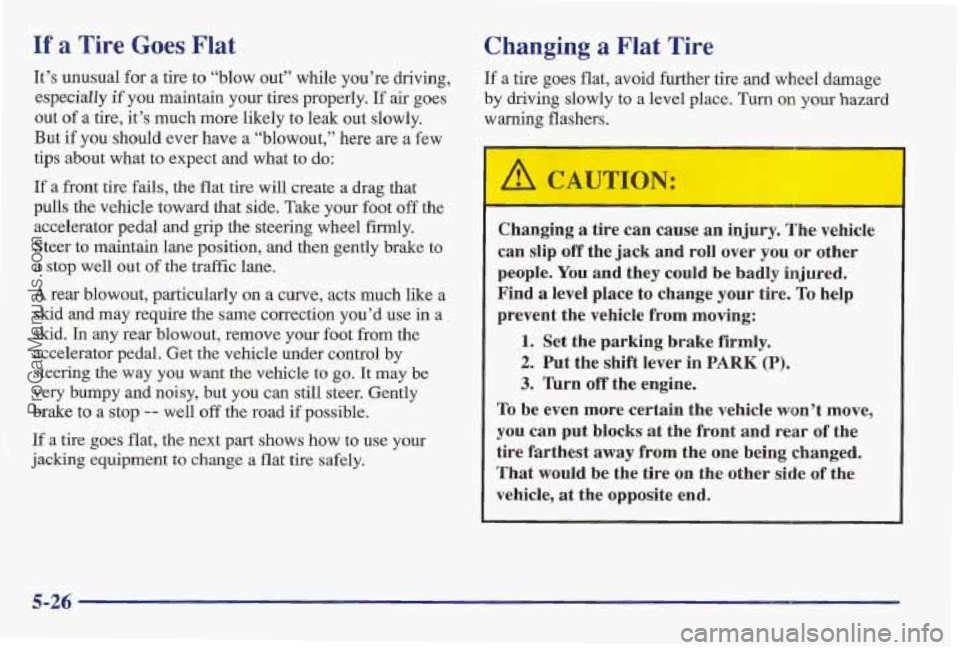Page 225 of 405
Attach T-hook chains on
both sides in the slotted
holes in the bottom of
the cradle, behind the
front wheels.
These slots are to be used when loading and securing to
car-carrier equipment.
Attach a separate safety chain around the outboard end
of each lower control arm.
5-12
ProCarManuals.com
Page 226 of 405
Front Towing (SE)
Attach T-hook chains on
both sides in the slotted
holes in the bottom of
the cradle, behind the
front wheels.
These slots are to be used when using sling-type
equipment
or when loading and securing to
car-carrier equipment.
Position a
4” x 4” wood beam across sling chains
contacting bottom
of the radiator support. Position the
lower sling crossbar directly under the fiont bumper.
5-13
ProCarManuals.com
Page 227 of 405
Attach a separate safety chain around the outboard end
of each control am.
Rear Towing
Tow Limits -- 55 mph (88 kmlh), 500 miles (800 km)
Attach T-hook chains to
~ slots in the bottom of the
floor pan directly ahead of
rear wheels on both sides.
No 4 ” x 4 I’ wood beam is needed.
5-14
ProCarManuals.com
Page 239 of 405

If .a Tire Goes Flat
It’s unusual for a tire to “blow out” whde you’re driving,
especially
if you maintain your tires properly. If air goes
out of a tire, it’s much more likely to leak out slowly.
But
if you should ever have a “blowout,” here are a few
tips about what to expect and what to
do:
If a front tire fails, the flat tire will create a drag that
pulls
the vehicle toward that side. Take your foot off the
accelerator pedal
and grip the steering wheel firmly.
Steer to maintain lane position, and then gently brake to
a stop well out of the traffic lane.
A rear blowout, particularly on a curve, acts much like a
skid and may require the same correction you’d use in a
skid. In any rear blowout, remove your foot from the
accelerator pedal. Get the vehicle under control
by
steering the way you want the vehicle to go. It may be
very bumpy and noisy, but you can still steer. Gently
brake to a
stop -- well off the road if possible.
If a tire goes flat, the next part shows how to use your
jacking equipment
to change a flat tire safely.
Changing a Flat Tire
If a tire goes fiat, avoid further tire and wheel damage
by driving slowly to a level place. Turn on
you. azard
w aming flashers.
Changing
a tire can cause an injury. The vehicle
can slip off the jack and roll over
you or other
people.
You and they could be badly injured.
Find
a level place to change your tire. To help
prevent the vehicle
from moving:
1. Set the parking brake firmly.
2. Put the shift lever in PARK (P).
3. Turn off the engine.
To be even more certain the vehicle won’t move,
you can put blocks at the front and rear of the
tire farthest away
from the one being changed.
That would
be the tire on the other side of the
vehicle, at the opposite end.
5-26
ProCarManuals.com
Page 241 of 405
The box that stores the
jack
and wheel wrench is
located on the passenger
side trunk wall.
Open the
box and then twist
the wing bolt one-quarter
turn counterclockwise.
Remove the
jack and wheel wrench.
5-28
ProCarManuals.com
Page 242 of 405
Removing Wheel Covers and
Wheel Nut Caps
Please note that nut caps will not remove from the
cover completely.
If you have aluminum
wheels with nut caps,
remove them.
If you have aluminum wheels and a center cover hides the
wheel nuts, remove the center cover
by using the flat end
of the wrench to pry it off. Do not drop the cover or lay it
face
down, as it could become scratched or damaged.
Do not use a hammer or mallet on this type of cover.
5-29
ProCarManuals.com
Page 243 of 405
Removing the Flat Tire and Inst'alling the
Spare Tire
1. Use the wheel wrench to loosen the wheel nuts, but
don't remove them.
2. Attach the wheel wrench to the jack, and rotate the
wrench clockwise
to raise the jack head a few inches.
Put the jack head into a notch in the frame which
is located near each wheel well. The front notch is
10 inches (25 cm) back from the front wheel well.
The rear notch is 8 inches (20 cm) forward from the
rear wheel well.
5-30
ProCarManuals.com
Page 245 of 405
I
4. Raise the vehicle by rotating the wheel wrench
clockwise
in the jack. Raise the vehicle far enough
off the ground so there is enough room for the spare
tire to fit.
5. Remove all the wheel nuts and take off the flat tire.
6. Remove any rust or dirt
from the wheel bolts,
mounting surfaces and
spare wheel.
Rust or dirt
on the wheel, or on the parts to
which it is fastened, can make the wheel nuts
become loose
after a time. The wheel could come
off and cause an accident. When you change a
wheel, remove any rust or dirt from the places
where the wheel attaches to
the vehicle. In an
emergency, you can use a cloth or a paper towel
to
do this; but be sure to use a scraper or wire
brush later,
if you need to, to get all the rust or
dirt off.
5-32 7
ProCarManuals.com